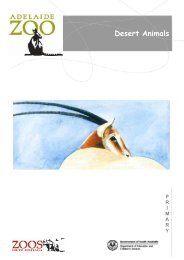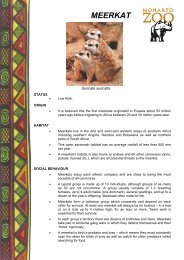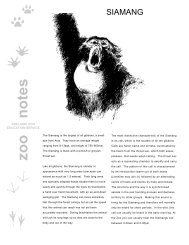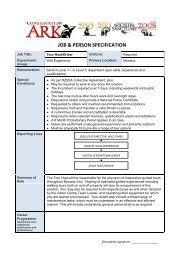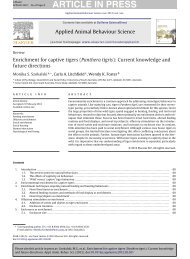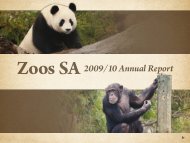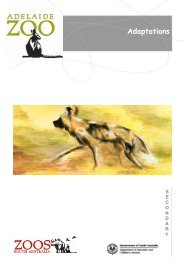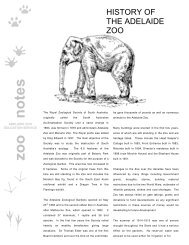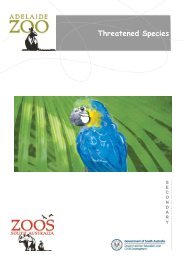2008 - 2009 Annual Report - Zoos South Australia
2008 - 2009 Annual Report - Zoos South Australia
2008 - 2009 Annual Report - Zoos South Australia
- No tags were found...
Create successful ePaper yourself
Turn your PDF publications into a flip-book with our unique Google optimized e-Paper software.
CONTENTSYear In ReviewPresident and CEO’s <strong>Report</strong>Conservation ProgramsAssets and InfrastructureConservation EducationThe AnimalsLiving collectionsStatus of Animal CollectionsAnimal InventoryThreatened SpeciesOperationsCommunications and PartnershipsVisitor ExperiencesHuman ResourcesFinancial <strong>Report</strong>FinalsIUCN Listed SpeciesThe World Conservation Union, previously the International Union for the Conservationof Nature and Natural Resources, has been assessing the conservation status of species,subspecies, varieties and selected subpopulations on a global scale for more than 40years. The categories and criteria are intended to be an easily and widely understoodsystem for classifying species at a high risk of extinction. Subsequently, by highlightingthese extinction threats, the IUCN hopes to promote their conservation. The IUCNRed List was updated in <strong>2008</strong>, with many species changing in their classification.Unfortunately, more were granted a more threatened status than previously. Refer toAppendix 2 for <strong>Zoos</strong> SA species of greatest concern under the IUCN categorisation.Adelaide ZooNB: The chart shows ‘Lower Risk’ and ‘Conservation Dependant’ at 0% - this is a result of rounding as there is a singlespecies at this levelMonarto Zoo%70 Not listed1 Data Deficient0 Conservation Dependent0 Lower Risk7 Near Threatened9 Vulnerable9 Endangered4 Critically EndangeredIUCN listed species are represented throughout most of the taxonomic groupsheld at Adelaide and Monarto <strong>Zoos</strong>. While the graph below indicates thecategories of IUCN listings throughout each of these groups (as determined by theASMP Taxon Advisory Groups), it does not give a true representation of numberswithin each group, but of a percentage within each group.Adelaide ZooAquaticArtiodactylBats & RatsCarnivoreMonarto ZooInvertobrateMarine mammalMisc. Exotic MammalMonotreme & marsupialNon-passerinePasserinesPeriss. & ProbPNG FaunaPrimateReptile & AmphibianNone/domesticNot listedData DeficientConservation DependentLower RiskNear ThreatenedVulnerableEndangeredCritically Endangered%Not Listed41 Not listedConservation Dependent2 Conservation DependentNear Threatened21 Near ThreatenedVulnerable11 VulnerableEndangered9 EndangeredCritically Endangered11 Critically Endangered5 Extinct in WildN.B. The Mala Lagorchestes hirsutus hirsutus is classified as ‘Extinct’ by the IUCN, last assessed in 1996 (the species L.hirsutus is listed as ‘Vulnerable’.ArtiodactylBats & RatsCarnivoresMonotreme & MarsupialNon-passerinePerriss. & ProbPrimateReptile & AmphibianExtinct in WildStatus of Animal Collections - 5 of 10



